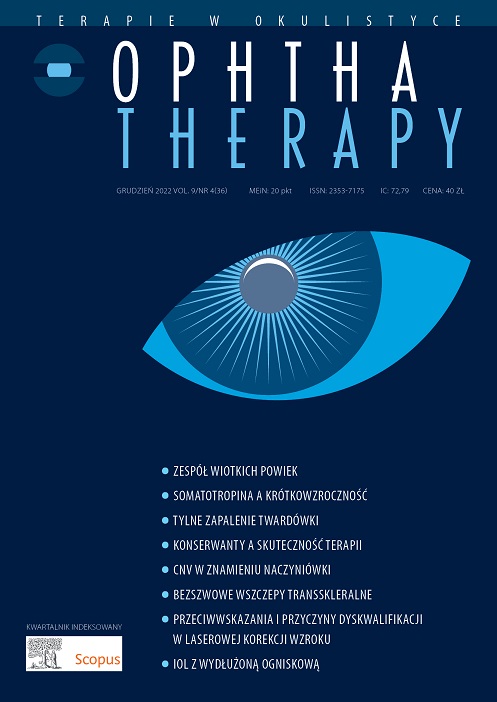Sutureless transscleral intraocular lens implantation ? own observation study Original research study
Main Article Content
Abstract
Aim of the study: Presentation of the results of Carlevale? intraocular lens implantation with a transscleral sutureless fixation method, based on our own experience.
Material and methods: The sutureless transscleral implantation of a Carlevale? lens was performed in 39 people (40 eyes) with postoperative aphakia after dislocation of lens, including 10 post-traumatic ones, and in one patient with a dislocated transscleral intraocular lens fixated with non-absorbable sutures. Patients were followed for 6 to 18 months.
Results: 80% of patients after surgery achieved visual acuity equal to or better than before surgery (20% achieved Snellen acuity 1.0 without correction). Intraoperative and postoperative complications were observed in slightly more than half of the patients. The most common were keratopathy, slight bleeding into the vitreous chamber, conjunctival wound dehiscence, and intraocular pressure fluctuations. Most of these complications did not have any lasting consequences.
Conclusions: Sutureless transscleral implantation of an intraocular lens seems to be an effective and relatively safe method of treating aphakia. However, the assessment of the durability of sutureless fixation requires further research.
Downloads
Article Details

This work is licensed under a Creative Commons Attribution-NonCommercial-NoDerivatives 4.0 International License.
Copyright: © Medical Education sp. z o.o. License allowing third parties to copy and redistribute the material in any medium or format and to remix, transform, and build upon the material, provided the original work is properly cited and states its license.
Address reprint requests to: Medical Education, Marcin Kuźma (marcin.kuzma@mededu.pl)
References
2. Dick HB, Augustin AJ. Lens implant selection with absence of capsular support. Curr Opin Ophthalmol. 2001; 12(1): 47-57. http://doi.org/10.1097/00055735-200102000-00009.
3. Tang Y, Xu J, Chen J et al. Long-Term Destiny of Corneal Endothelial Cells in Anterior Chamber Intraocular Lens Implanted Eyes. J Ophthalmol. 2020; 2020: 5967509. http://doi.org/10.1155/2020/5967509.
4. Soleko IOLDivision. Charakterystyka produktu, karta katalogowa FIL SSF Carlevale Lens.
5. Vaiano AS, Hoffer KJ, Greco A et al. Long-term Outcomes and Complications of the New Carlevale Sutureless Scleral Fixation Posterior Chamber IOL. J Refract Surg. 2021; 37(2): 126-32. http://doi.org/10.3928/1081597X-20201207-02.
6. Fiore T, Messina M, Muzi A et al. A novel approach for scleral fixation using Carlevale lens. Eur J Ophthalmol. 2021; 31(6): 2947-54. http://doi.org/10.1177/1120672121991358.
7. Georgalas I, Spyropoulos D, Gotzaridis S et al. Scleral fixation of Carlevale intraocular lens: A new tool in correcting aphakia with no capsular support. Eur J Ophthalmol. 2022; 32(1): 527-33. http://doi.org/10.1177/1120672121992978.
8. Rouhette H, Meyer F, Pommier S et al. FIL-SSF Carlevale intraocular lens for sutureless scleral fixation: 7 recommendations from a serie of 72 cases. MICA study (Multicentric Study of the Carlevale IOL). J Fr Ophtalmol. 2021; 44(7): 1038-46. http://doi.org/10.1016/j.jfo.2021.05.002.
9.Mularoni A, Imburgia A, Forlini M et al. In vivo evaluation of a 1-piece foldable sutureless intrascleral fixation intraocular lens using ultrasound biomicroscopy and anterior segment OCT. J Cataract Refract Surg. 2021; 47(3): 316-22. http://doi.org/10.1097/j.jcrs.0000000000000444.
10. Sindal MD, Nakhwa CP, Sengupta S. Comparison of sutured versus sutureless scleral-fixated intraocular lenses. J Cataract Refract Surg. 2016; 42(1): 27-34. http://doi.org/10.1016/j.jcrs.2015.09.019.

